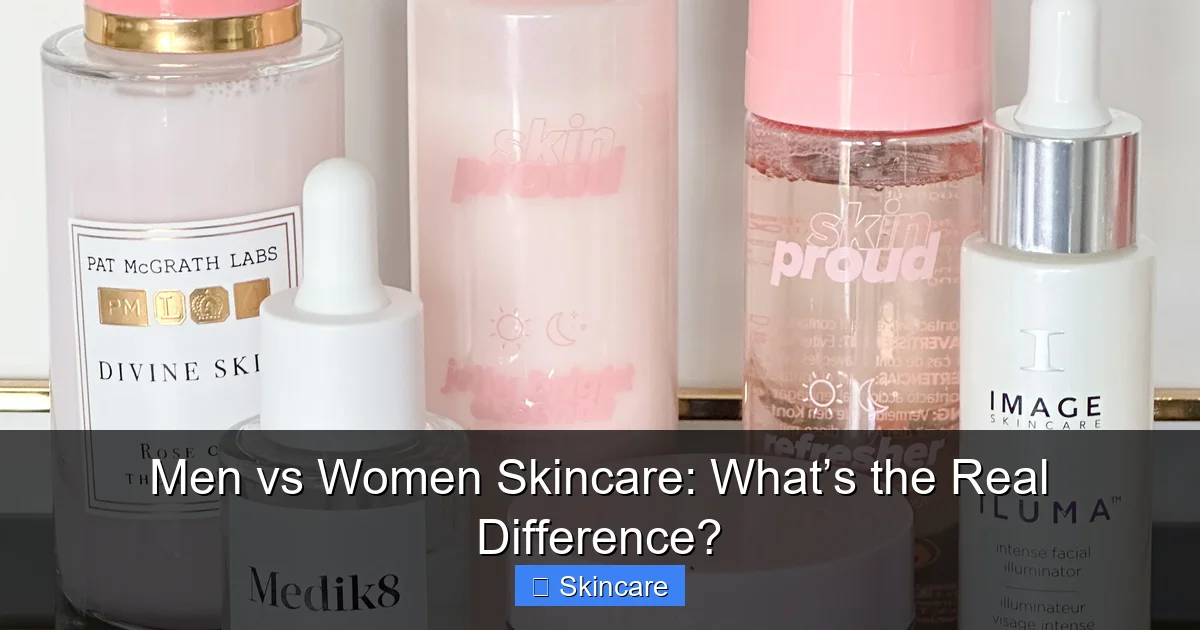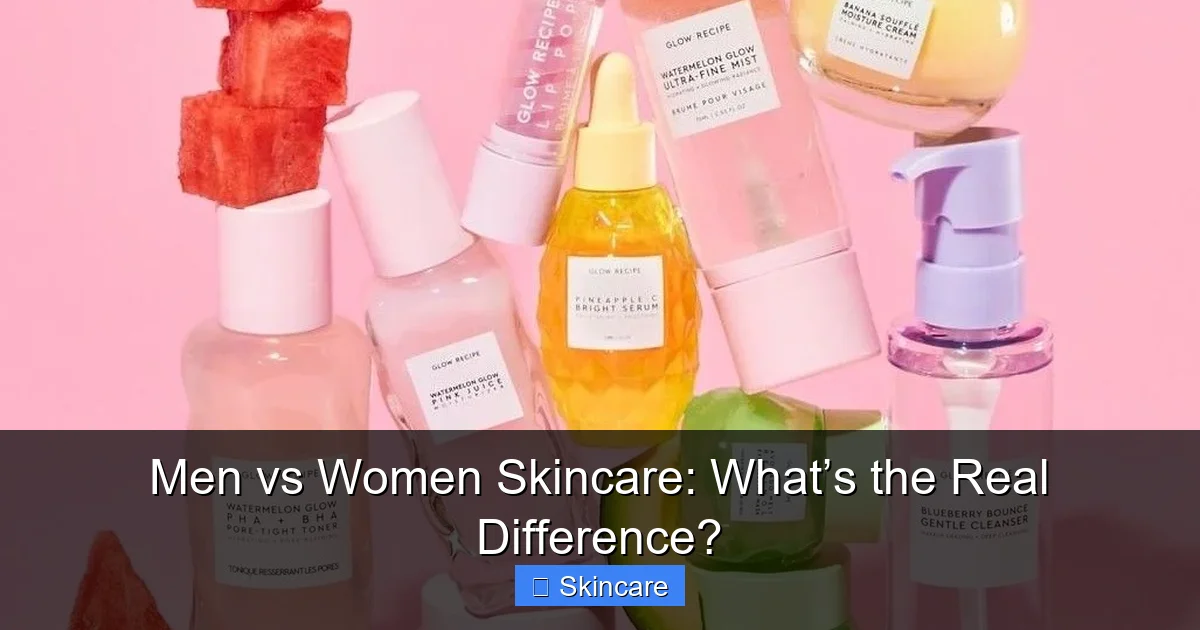
Featured image for this comprehensive guide about is skincare different for men and women
Image source: blogger.googleusercontent.com
Men vs Women Skincare: What’s the Real Difference?
For decades, the beauty industry has marketed skincare products along strict gender lines. Walk into any store, and you’ll see shelves clearly divided: “for him” and “for her.” But beyond the packaging and fragrances, is skincare different for men and women in a fundamental way? Is your skin’s biology truly so distinct that it requires entirely separate product formulations?
This is a question many people ponder, leading to confusion and often unnecessary spending. While there are undeniable biological differences between male skin and female skin, the modern understanding of skincare emphasizes individual needs over gender. In this comprehensive guide, we’ll dive deep into the science, debunk common myths, and help you understand how to tailor a truly effective skincare routine – regardless of your gender.
📋 Table of Contents
- The Biological Blueprint: Are Male and Female Skin Truly Different?
- Common Skincare Concerns: A Gendered Perspective?
- The Rise of Gender-Neutral Skincare: Is “Unisex” the Future?
- Tailoring Your Routine: Focus on Skin Type and Concerns, Not Gender
- Skincare Product Trends & Statistics
- Actionable Skincare Tips for All
- Conclusion: It’s About Skin, Not Gender
The Biological Blueprint: Are Male and Female Skin Truly Different?
Yes, at a fundamental biological level, there are some significant differences between male skin and female skin, primarily driven by hormones. These distinctions influence everything from skin thickness to oil production.
Hormonal Influences: Testosterone vs. Estrogen
- Testosterone (Male): Generally leads to thicker skin, about 20-25% thicker than female skin. This thicker epidermis often translates to a firmer texture and a higher collagen density, which means men might show signs of aging later, but when wrinkles do appear, they can be deeper. Testosterone also stimulates larger pores and greater sebum (oil) production, making men’s skincare often focused on oil control and acne prevention.
- Estrogen (Female): Contributes to thinner skin, with less collagen and elastin density than men prior to menopause. This can make female skin more prone to dryness and sensitivity. Estrogen also plays a role in maintaining hydration, but after menopause, declining estrogen levels can lead to a significant increase in dryness, loss of elasticity, and accelerated aging.
Hair Follicles and Shaving
One of the most apparent distinctions is facial hair. Men typically have more and thicker terminal hair on their faces, requiring regular shaving. This daily ritual is a major factor in men’s skincare, often leading to:
| Skin Characteristic | Men’s Skin Profile | Women’s Skin Profile |
|---|---|---|
| Thickness | Approximately 20-25% thicker due to higher testosterone levels. | Generally thinner and more delicate, potentially showing fine lines earlier. |
| Sebum Production | Produces up to 2x more oil (sebum), leading to larger pores and increased acne risk. | Tends to produce less sebum, leading to drier skin, especially with age or hormonal shifts. |
| Collagen Density | Higher collagen density, making skin firmer and more resistant to initial signs of aging. | Lower collagen density, potentially leading to earlier appearance of wrinkles and loss of elasticity. |
| pH Level | Slightly more acidic (lower pH, typically 4.5-5.0). | Slightly less acidic (higher pH, typically 5.0-5.5). |
| Shaving Impact | Daily facial shaving can cause micro-traumas, irritation, razor burn, and ingrown hairs. | No daily facial shaving impact, generally less susceptibility to this type of external irritation. |
- Razor burn and irritation.
- Ingrown hairs (pseudofolliculitis barbae).
- Micro-cuts and increased sensitivity.
Sebum Production
On average, men have more active sebaceous glands and produce twice as much sebum as women. This higher oil production can lead to a more persistently oily complexion, larger pores, and a greater predisposition to acne breakouts. While women’s skincare can also address oily skin, it’s a more common and often more pronounced skin concern for men.
Common Skincare Concerns: A Gendered Perspective?
While the underlying biology creates different starting points, many skin concerns overlap. However, how these concerns manifest or are prioritized can differ between genders, influencing perceived needs for skincare different for men and women.

Learn more about is skincare different for men and women – Men vs Women Skincare: What’s the Real Difference?
Image source: i.pinimg.com
Men’s Skincare Concerns Often Include:
- Shaving-Related Issues: Razor bumps, nicks, sensitivity, and redness are paramount for many men.
- Oiliness and Acne: Due to higher sebum production, managing shine and breakouts is a frequent need.
- Sun Damage: Historically, men have been less diligent about sun protection, leading to cumulative sun damage.
- Signs of Aging: While appearing later, deep wrinkles and loss of firmness are significant concerns as men age.
Women’s Skincare Concerns Often Include:
- Dryness and Sensitivity: Thinner skin and hormonal fluctuations can lead to increased dryness and reactivity.
- Hormonal Acne: Cyclical breakouts tied to the menstrual cycle or conditions like PCOS are common.
- Fine Lines and Wrinkles: Earlier onset due to thinner skin and less initial collagen density.
- Hyperpigmentation: Melasma and post-inflammatory hyperpigmentation are often hormonal or sun-induced concerns.
The Rise of Gender-Neutral Skincare: Is “Unisex” the Future?
In recent years, there’s been a significant shift in the beauty industry towards gender-neutral skincare. This movement acknowledges that while biological differences exist, the fundamental principles of good skincare apply to everyone. Brands are increasingly focusing on ingredients and concerns rather than traditional gender roles.

Learn more about is skincare different for men and women – Men vs Women Skincare: What’s the Real Difference?
Image source: static.independent.co.uk
The truth is, a good cleanser, a powerful antioxidant serum, a hydrating moisturizer, and a broad-spectrum SPF don’t discriminate. Active ingredients like hyaluronic acid, Vitamin C, niacinamide, and retinoids work effectively on all skin types and genders because they target universal skin functions and issues like hydration, collagen production, and cell turnover. This trend highlights that effective skincare different for men and women is less about gender and more about addressing specific skin type and skin concerns.
Tailoring Your Routine: Focus on Skin Type and Concerns, Not Gender
The most effective approach to skincare is to personalize your routine based on your individual skin type (oily, dry, combination, normal, sensitive) and specific skin concerns, not whether you identify as male or female. This is where true personalization of skincare different for men and women comes into play.
Key Steps for Everyone: The Universal Foundation
- Cleanse: Remove dirt, oil, and impurities.
- Treat: Address specific concerns with targeted serums (e.g., Vitamin C for brightness, salicylic acid for acne, hyaluronic acid for hydration).
- Moisturize: Hydrate and protect the skin barrier.
- Protect: Always apply a broad-spectrum SPF 30+ every morning.
Customization is Key:
- For Oily/Acne-Prone Skin (common in men): Opt for gel cleansers, oil-free moisturizers, and products with ingredients like salicylic acid or niacinamide to regulate sebum and prevent breakouts.
- For Dry/Sensitive Skin (common in women): Choose cream cleansers, richer emollients, and ingredients like ceramides, hyaluronic acid, and gentle humectants to boost hydration and soothe irritation.
- For Anti-Aging Concerns: Both genders benefit from retinoids, peptides, and antioxidants to combat fine lines, wrinkles, and loss of firmness.
- For Shaving-Related Issues: Men should incorporate a pre-shave oil, a sharp razor, and a soothing, alcohol-free post-shave balm.
Skincare Product Trends & Statistics
The market reflects this evolving understanding. While separate lines still exist, the emphasis is shifting.
- Growth of Men’s Grooming: The global men’s personal care market was valued at USD 30.8 billion in 2022 and is projected to grow significantly, indicating increased awareness and product adoption among men. This growth isn’t just about shaving; it’s about comprehensive men’s skincare.
- Ingredient-Focused Purchasing: Consumers of all genders are increasingly seeking out products based on their active ingredients and proven efficacy, rather than just brand or packaging.
- Rise of “Skinimalism”: Many are opting for simpler, more effective routines with fewer, high-quality products that cater to their specific needs.
- Increased SPF Adoption: Awareness of sun protection benefits is growing across all demographics, with more men recognizing the importance of daily SPF.
This data points to a future where skincare different for men and women becomes less about gendered branding and more about personalized care based on science.
Actionable Skincare Tips for All
Regardless of your gender, these tips will help you build an effective and sustainable skincare routine:
- Cleanse Twice Daily: Use a gentle cleanser suited to your skin type.
- Moisturize Regularly: Hydration is crucial for a healthy skin barrier.
- Always Use SPF: A broad-spectrum SPF of at least 30 is non-negotiable for protecting against sun damage and premature aging.
- Introduce Actives Gradually: If using ingredients like retinoids or acids, start slowly to allow your skin to adjust.
- Listen to Your Skin: Pay attention to how your skin reacts to products and adjust your routine accordingly.
- Stay Hydrated: Drinking enough water contributes to overall skin health.
- Consult a Dermatologist: For persistent issues or severe concerns, professional advice is invaluable.
Conclusion: It’s About Skin, Not Gender
So, is skincare different for men and women? Biologically, yes, there are differences in skin thickness, oil production, and aging patterns. However, when it comes to creating an effective skincare routine, focusing solely on gender is an outdated approach. The most impactful decisions you can make for your skin revolve around understanding your unique skin type and primary skin concerns.
Embrace the power of personalized care. Whether you’re interested in men’s skincare or women’s skincare, the goal remains the same: healthy, radiant skin. By choosing products and practices that cater to your individual needs, you can achieve your best skin yet, free from gender constraints.
“`
🎥 Related Video: My Evidence-Based Skincare Routine
📺 Ali Abdaal
Make money with the skills you already have: https://go.aliabdaal.com/lbaytd Join my FREE quarterly goal-setting and reflection …
Frequently Asked Questions
Is there a biological difference between men’s and women’s skin?
Yes, there are significant biological differences. Men’s skin is generally thicker, has larger pores, produces more sebum (oil), and boasts higher collagen density due to androgen hormones like testosterone. Women’s skin tends to be thinner and can experience more dryness and hormonal fluctuations.
Do men and women need different skincare products?
While the core principles of cleansing, moisturizing, and sun protection apply to everyone, specific product formulations can benefit from considering these biological differences. Products for men often address oiliness and post-shave irritation, while women’s products might focus more on hydration and anti-aging due to varying concerns.
Can men use women’s skincare products, and vice-versa?
Absolutely! Skincare is ultimately about addressing individual skin types and concerns, not gender. If a woman’s moisturizer effectively hydrates a man’s dry skin, or a man’s oil-control cleanser works for a woman, there’s no reason not to use it.
What are the main differences in skincare concerns for men vs. women?
Men frequently deal with issues like razor burn, ingrown hairs, excess oiliness, and sun damage, often due to outdoor exposure. Women commonly focus on hydration, signs of aging (fine lines, wrinkles), hormonal breakouts, and specific sun protection needs.
Is “men’s skincare” just a marketing gimmick, or is there a real difference?
While some “men’s skincare” branding is indeed marketing, there can be real differences in product formulation. Men’s products often consider thicker skin, higher oil production, and the common need to soothe post-shave irritation. However, the most effective skincare always targets specific skin concerns, irrespective of gender labels.
Are men’s skincare routines inherently simpler than women’s?
Traditionally, men’s routines have been marketed as simpler, often focusing on basic cleansing and moisturizing. However, the complexity of a routine should align with an individual’s skin needs and goals, regardless of gender. Many men are now adopting multi-step routines, just as many women prefer minimalist approaches.
